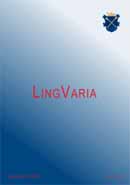Skąd poszły strulki i hancle?
Where do Polish strulki and hancle, the names of a children’s game, come from?
Author(s): Marek StachowskiSubject(s): Language and Literature Studies
Published by: KSIĘGARNIA AKADEMICKA Sp. z o.o.
Summary/Abstract: David L. Gold (2009: 578sq.) is right when he supposes that s(h)trulkes, a Yiddish name of a certain children’s game, is a reflex of a Polish name such as *sztrulki ~ *strulki. Indeed, both those Polish forms exist and thus do not need to be asterisked. Several other Polish variants exist too, such as sztulki and sztule, as does an entirely different Polish name of this game, hacele ~ hacle ~ hancle. The present author shows that both strulki and hacle originally designated a kind of ‘horseshoe stud or screw’ used in the game (in the course of time the screws were replaced mostly by small stones). In both cases, the name of the game is formally a plural noun (thus meaning ‘studs, screws’) < sing. *s(z)trulka ~ *s(z)trulek ~ *sztula ~ sztul and hacel, respectively. Whereas hacel seems to come from Polish ocel ‘horseshoe stud’ < Czech ocel (or, maybe, rather < Slovak < Hungarian < Czech) ‘steel’ (<< Latin), the word *s(z)trulka presumably derives from Polish sztul ~ *sztula, which either reflects German Stolle(n) ‘horseshoe stud’ or is a blend of that German word and German Stuhl ‘girder, support; underlayment, bottom layer’ (lit. ‘chair’) (DWG).
Journal: LingVaria
- Issue Year: 2012
- Issue No: 13
- Page Range: 133-137
- Page Count: 5
- Language: Polish

